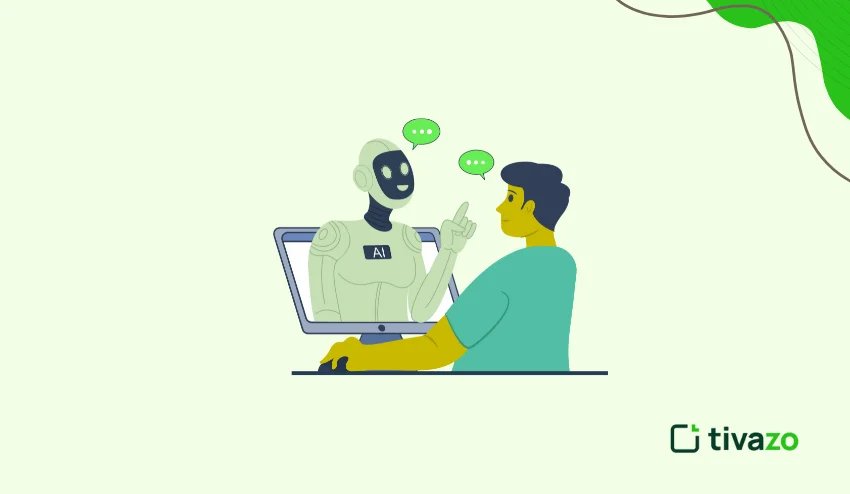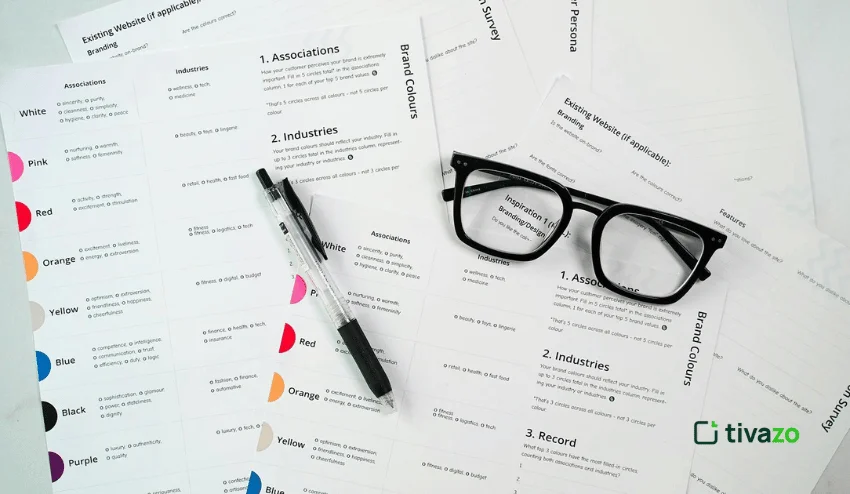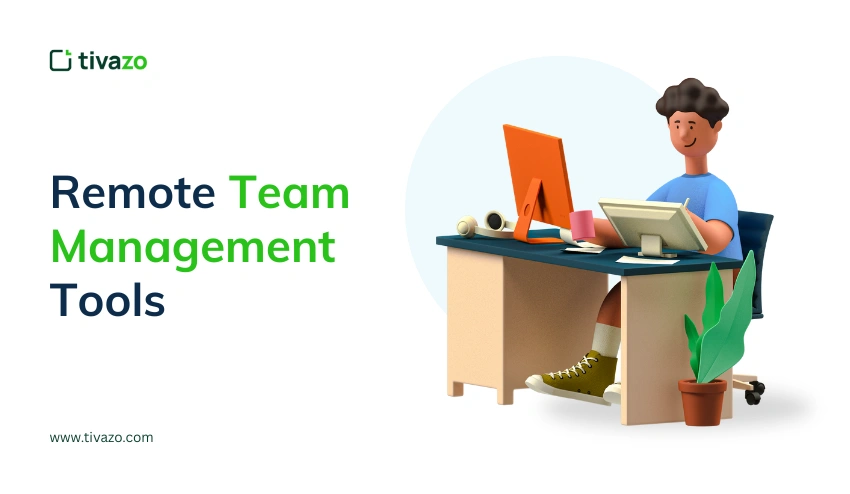Modern software development is increasingly reliant on artificial intelligence. AI-powered tools can theoretically accelerate workflows and reduce human error in several important ways: generative AI can automate code generation, debugging, and testing — particularly for mobile app solutions. Despite these benefits, the technology is no silver bullet. Organizations must understand when generative AI provides a unique benefit versus a human with expertise in the subject is irreplaceable.
Key Highlights:
- What Are Generative Tools
- Example of a Generative AI Tool
- Generative AI in Software Development
- Powerful Ways Generative Tools Enhance Code in AI Development
- DevOps, AI, and the Role of Automation
What Are Generative Tools?
Generative tools are AI systems that generate new content, code, or solutions based on existing data. It depends on machine learning models to automate repetitive tasks like code generation or documentation.
- Improves code quality: Helps find bugs and efficiencies.
- AI-driven: Learns patterns from data to implement for automation.
- Enhances productivity: Saves time on repetitive or routine tasks.
What Is an Example of a Generative AI Tool?
An example of a generative AI tool is GitHub Copilot. It was built by GitHub and OpenAI; GitHub Copilot provides developers with code suggestions in real time. Copilot understands the topic you’re working on and can run AI models trained on massive datasets to provide relevant code snippets for your project. Essentially, Copilot allows developers to write code more effectively, so it is a productivity tool.
- Boosts productivity: In particular, by enabling automating the most repetitive parts of development, like creating common functions or boilerplate code, Copilot allows more time for the hard development work, think of coding Project A (keep it pretty smooth), while all you have to worry about is the relevant functionality and coding.
- Instant code suggestions: Finally, as you type, Copilot can auto-complete lines of code, functions, or entire algorithms based on the code you have written and the general context of the code.
- Contextual understanding: Copilot also analyzes the code and understands the logic of the code. It can give you suggestions that are appropriate to the context – an example would be suggesting a sorting algorithm in relation to handling an array or database operations specific to an SQL query.
Generative AI in Software Development: Opportunities and Limitations
Developers’ work with generative AI has irrevocably changed the way they write and “refactor” code with a few clicks or keystrokes. Generative AI methods utilize extensive language models trained on more than a billion data sets, input/output instructions, and protocols. This might characterize their ability to generate user-defined, boilerplate structures or an entire architecture of your application in real-time.
However, organizations should not treat these tools as a one-size-fits-all replacement. AI excels in pattern recognition and automation, but it struggles with contextual decision-making, long-term maintainability, and domain-specific constraints. For this reason, many companies choose to integrate AI tools alongside traditional expertise, often in partnership with a data analytics services and solutions provider, to better assess where automation adds efficiency and where human oversight remains essential. Partnering with a Generative AI Development Service can further help organizations tailor AI-driven solutions to their specific software development needs while maintaining control, quality, and scalability.
The Strengths of Generative AI in Development
Generative tools offer several advantages to software engineering that can be leveraged in strategic ways:
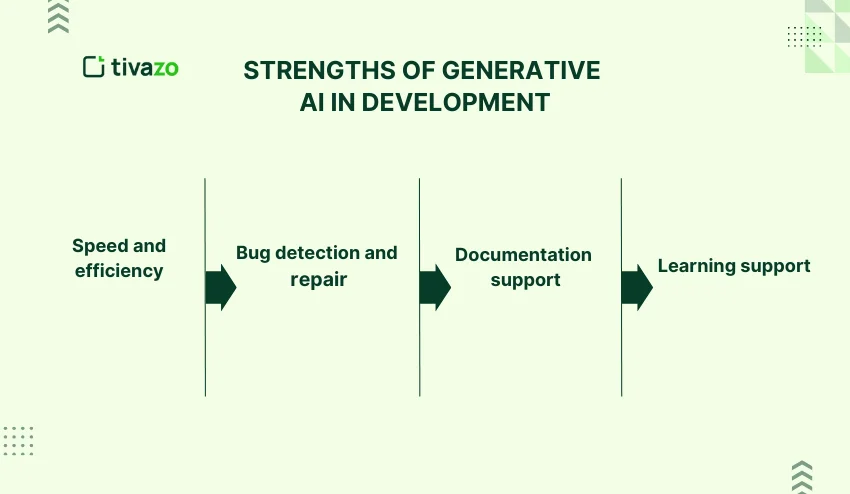
- Speed and efficiency: AI can generate repetititve structures or scaffolding for the template code in seconds.
- Bug detection and repair: AI can identify vulnerabilities or suggest repair by recognizing structures and patterns in massive datasets or continuous code dumps.
- Documentation support: Some of those tools can generate or summarize documents which reduces the documentation workloads of developers.
- Learning support: For junior developers, AI tools become an on-demand tutor by explaining or recommending syntax and other ideas.
The Weaknesses Developers Must Recognize
AI tools can indeed accelerate software development; however, they cannot replace all the facets of software engineering. There are some institutional limitations, including:
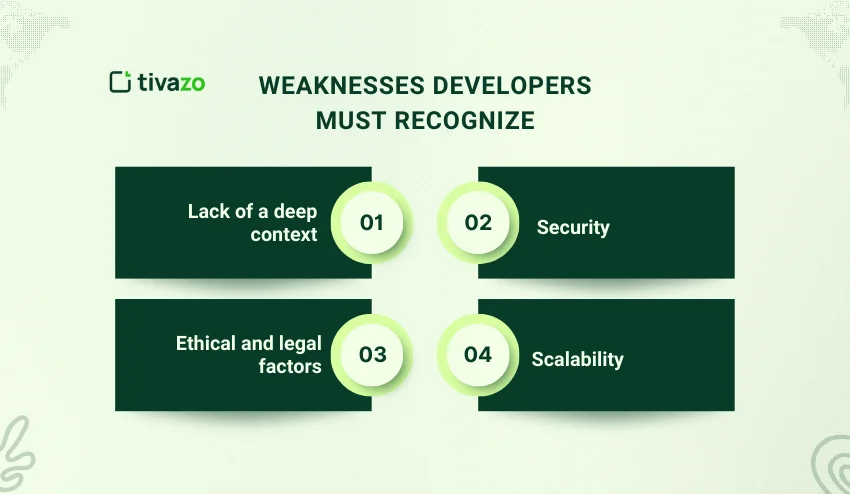
- Lack of a deep context: AI tools cannot understand unique business logic or industry-specific compliance issues.
- Security: Code generated by AI may inadvertently introduce vulnerabilities back into the environment, which requires a manual code review. To ensure the continuous efficiency and quality of this essential human oversight, implementing a software engineering intelligence platform like Swarmia is crucial for tracking review times and flow efficiency.
- Ethical and legal factors: AI using training data to generate code raises additional questions with intellectual property rights.
- Scalability: While there are efficiencies to generating code with AI, in complex projects there is usually a maintainability plan that raises questions AI cannot guarantee because it can only operate at the moment in time where the conditions are true.
5 Powerful Ways Generative Tools Enhance Code in AI Development
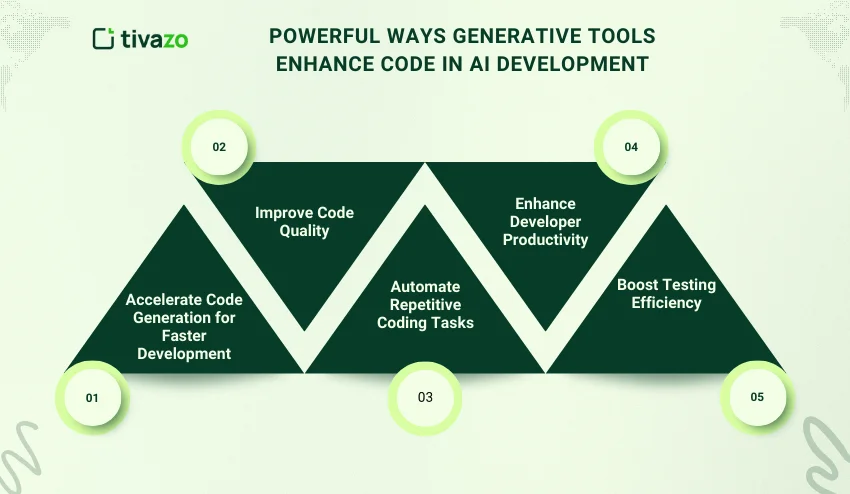
1. Accelerate Code Generation for Faster Development
Generative tools, powered by AI, are great for speeding up the coding phase of software development because they can instantly generate repetitive or reusable code. This is helpful in that it allows developers to avoid coding common structures, like templates, functions, modules, etc. and instead focus on the more sophisticated aspects of the software project.
- Instant code generation: AI can generate boilerplate code quickly and save them from routine work.
- Less manual work: Developers can avoid repetition in coded tasks, using it for real problem-solving instead.
- Faster project delivery: Developers’ quicker coding cycle leads to faster project closures.
2. Improve Code Quality with AI-Powered Bug Detection
AI tools can also examine sizable codebases of code for bugs, security issues, or inconsistencies. As mentioned above, these tools can not only analyze and report on any syntax, but can analyze logic flaws, performance issues, or security risks that are normally untraceable by human reviewers.
- Detects bugs early: AI will detect bugs early to eliminate future problems.
- Suggests fixes: AI tools make suggestions to apply in real time to fix bugs/de-bug the code.
- Improves code quality: Because AI detects most issues early on, the code base is more reliable and secure.
3. Automate Repetitive Coding Tasks to Save Time
Writing code can involve a very tedious aspect: coding the same code over again, such as boilerplate code or unique functions across different areas of the application. Generative contributions can handle that repetitive code automatically, with a significant boost to developer productivity.
- Automatically writes boilerplate: AI can efficiently create docblocks, API endpoints, data models, or form validations with AI, quickly writing standard components.
- Faster routine tasks: Automating code writing takes typical time-consuming, mundane tasks off of the developer’s hands entirely.
- Less human error: Coded AI that handles repetition will greatly reduce redundancy and instances that cause human errors
4. Enhance Developer Productivity with AI-Driven Documentation
Keeping documentation clear and up to date can be tedious work for developers, but documentation can be critical to team collaboration, and future code maintenance. AI can ease the burden that documentation requires by automatically creating documentation with explanation and examples by analysis of the code.
- Automatically writes explanation: AI observes documentation and creates documentation in several different ways that illustrates the function and intent of block code, methods, or classes.
- Saves significant time: Documentation does not have to be written manually, therefore the coding is freed-up for deeper, technical undertakings or repetitive tasks.
- Promotes team collaboration: Well-documented code allows others easily collaborate and read or understand the code and information.
5. Boost Testing Efficiency with AI-Based Test Generation
AI-driven tools can automatically generate test cases to confirm full test coverage of the application. These tools review code, leveraging the behavior of the application to create unit tests, integration tests, and performance tests, and find bugs and issues triaged before they become substantial problems.
- Generates unit and integration tests: AI automatically creates tests based on the code it reviews, saving developers time.
- Finds edge cases: AI can predict and test situations a developer could miss in coverage and testing.
- Increases test coverage: By automatically generating a variety of tests, the overall quality and reliability of the software improve.
When Human Expertise Outshines Generative Tools
AI should be considered an assistant rather than a substitute. Human developers contribute creativity, problem-solving and adaptability into their projects and machines are limited in these elements. Some situations require human insight and foresight.
Examples of Human-Centered Strengths
- System architecture design: A sustainable architecture requires a solid understanding of the infrastructure and the business requirements over time.
- Ethical coding decisions: Developers need to bring an ethical lens to software that safeguards privacy, fairness, and compliance.
- Cross-functional visibility and synergy: Communication between different departments, stakeholders, and end-users is essential for successful delivery.
- Custom connections: AI-generated solutions typically fail to connect easily to legacy applications.
In all these areas, humans are necessary to help ensure AI-generated information meets business needs and technical requirements.
DevOps, AI, and the Role of Automation
DevOps is yet another area where routines intersect with development. Automated, people-driven practices have always been a foundational practice for DevOps; however, AI expands that work by predicting failure of systems, predicting demand, optimizing synergies, and tracking performance.
However, just as with coding, AI is not going to replace the strategic aspects of decision-making that are involved with continuous integration and delivery pipelines. This is why organizations often partner with a DevOps services company to combine the efficiency that is available through AI with the intimate capabilities of an experienced expert. When this is done, the organization can be confident that automation is helping the flow in which work is done, with the promise that it will not disturb stability and security.
AI-Enhanced DevOps Benefits
AI is fundamentally transforming how DevOps works through automation in key aspects of it’s value: monitoring teams or systems, resource identification and management, feedback and security. AI -integrated tools are enhancing operational efficiencies; at the same time they are capable of improving predictive management through monitoring for potentially interfering events proactively, dynamically scaling resources, and assuring security in increasingly complex environments. Tools that leverage AI can utilize the data collected through monitoring that is done on a regular basis to provide actionable, timely insights into operations and management to facilitate decisions and to improve the performance of the organization.

- Predictive Monitoring: AI can analyze logs and identify anomalies before downtimes occur.
- Resource Optimization: Automated scaling allows for a reduction in infrastructure cost.
- Continuous Feedback Loops: AI offers real-time guidance on the performance of a system and how to respond.
- Security Enhancement: Machine learning models provide detection of behavioral patterns across environments that could indicate concern.
Best Practices for Balancing AI and Human Expertise
Companies can provide their companies the best of AI without succumbing to the pitfalls of chatGPT and other AI integrated experiences by adopting a balance. Here are some best practices:
- Use AI for mundane work: Use generative tools such as Github’s Copilot, Sonar Cloud and others to automate boilerplate code, automating test cases, and making routine fixes.
- Ensure human oversight: Review AI generated code, AI code needs to be reviewed for compliance, security and scalability.
- Use an hybrid workflow: Use AI driven tools in the DevOps practice to enhance team development pipeline resilience.
- Use training: Focus on creating knowledge bases, to implement teams using AI tools without over-relying on results from AI.
- Use trusted advisors: Sites like sombrainc.com provides you with guidance on the integration of AI and low-code solutions into an enterprise business strategies.
Integrating Generative Tools with Traditional Development Practices
Generative tools can bring many benefits, but marrying generative tools with legacy development approaches will give you confidence that the product is secure, scalable, and built to the right architecture. The hybrid approach will allow the benefit of both AI and human judgment to exist.
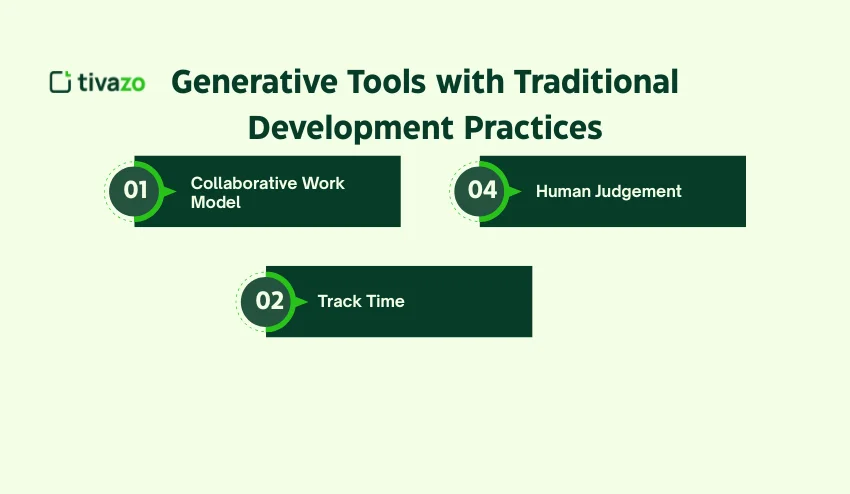
- Collaborative Work Model: Developers will still take advantage of generative tools for repetitive coding work, and can still apply their validation and guidance and business domain knowledge to make AI aware of what is appropriate for architecture, scaling, and custom solutions.
- Human Judgement: AI tools must always be a tool, not the designer. Human developers play a critical role because of their human judgement to always validate that the coded instruction provided by AI is secure, performant, and appropriate to human business logic.
- Increased Productivity in Workflows: Introducing AI to the workflow increases the productivity of the entire team as both humans and AI ability work together.
Conclusion
Generative AI is an extremely valuable tool in the development space today. It can bring speed, efficiency and automation. Clearly, we don’t want to over play the AI part – while it can facilitate faster coding, as well as automating many tasks and enabling tools for DevOps, it does lack the subtle context shifts and flexibility that only humans can bring to the picture.
The challenge is knowing when to leverage your AI skills vs. when to leverage your expert knowledge. Organizations that figure out how to balance this will develop not only faster cycles of development, but develop safer, scalable, and more innovative solutions that will last over time.

